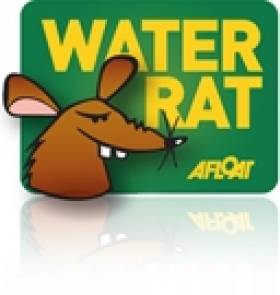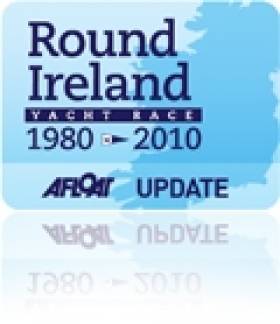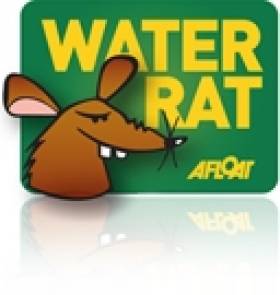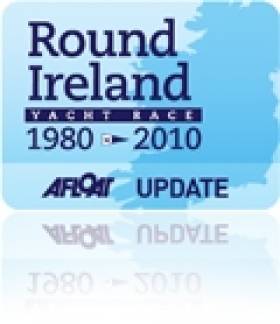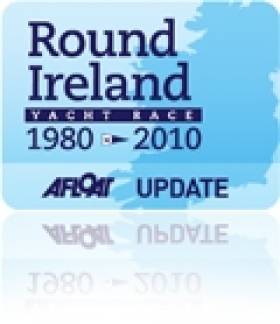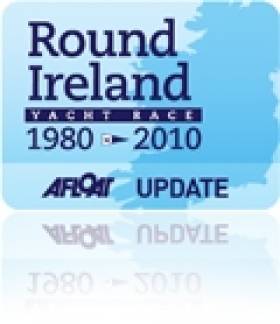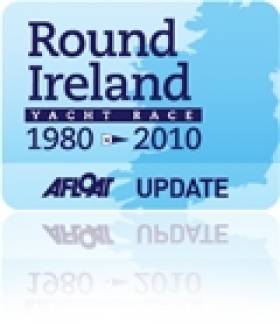Displaying items by tag: Wicklow SC
Current Affairs to Dominate Round Ireland Today
As the leaders of the Conway Media Round Ireland Yacht Race enter the northern end of the Irish Sea, today will be all about current affairs, so be prepared to watch the teams' fates ebb and flow with the vagaries of Northern Irish tides. Tonnerre de Breskens and Spirit of Rosslare Europort are currently being hurried around the north-east corner by the end of a flood tide. However, Larne saw high water come and go at 08.11 this morning. That means that the leaders and those in their wake (Inis Mor and Daft.com) have maybe an hour of slack water before things turn against them and they end up jogging on a nautical treadmill. Adding to the impending misery, those east of Malin Head are in light airs, whereas those off the Donegal coast and even further back have stronger following winds whisking them up the rankings in handicap terms and helping them battle the tide. Tonnerre and Rosslare are past Rathlin, but not out of the woods yet.
Low Water at Larne is at 1418hrs, and how much the fleet will compress before then could well define how the results pan out when the finishers hit Wicklow.
One curiosity now will be who gets line honours.
Favourite before the race was the Open 60 Spirit of Rosslare Europort, the one boat in the fleet with the potential for greatest speed. However they've failed to make gains when the conditions were in their favour, and now face upwind conditions, or a fetch at best, down the Irish Sea. Open 60s are built for downwind sailing, and this will do them no favours.
They're duelling with the Dutchmen on Tonnerre de Breskens, who have sailed a near impeccable race so far, in line with their winning form on the RORC circuit, and led the IRC rankings at the last mark. From the Spirit of Rosslare Europort blog earlier this morning: "Passed Rathlin Island and chasing Tonnerre de Breskens 3 hard. We are set for a great duel down the Irish sea. We are sailing with 3.4knts of favourable tide but this is due to change at about 09.30 this morning as the tide turns foul.
"While we are on a IMOCA 60 - We have to take our hats off to the Guys on “Tonnerre de Breskens 3” - They are sailing that Ker 46 to her max."
Further back, Inis Mor is the main challenger for the overall title, with Visit Malta Puma pushing hard and the pair of them battling with the youngsters on Pride of Wicklow who have put in a valiant debut performance in a race that has thrown up ideal conditions for an opening foray into offshore sailing.
Psipsina continues to hold onto her double-handed lead, and could do some further damage to Daft.com's lead on the water around the top. Daft.com have been struggling with their on-board alternator, meaning that their on-board electronics have been used sparingly. This may have made things difficult for blind sailor Mark Pollock, reliant on a power-hungry audio nav system to help him steer the boat while Mick Liddy sleeps. (UPDATE: Mark Pollock just tweeted to say that their backup autohelm cut out during a gybe, and they report a suspected cracked spreader. Kite is down and they are assessing what to do)
Boats can now call in race reports from the water direct to our webmaster's voicemail for use as podcasts, just dial 08652570320 and leave your report after the beep, and we'll get it up online as soon as possible.
Have your say on the racing in our forum thread HERE.
The race tracker is HERE, and the official site is HERE.
More on the Round Ireland Yacht Race:
Round Ireland Yacht Race 2010 Review
Round Ireland Yacht Race, Ireland's top offshore fixture
A Round up of 80 stories on the 2010 Round Ireland Yacht RaceFrance v Holland in tomorrow's Round Ireland Final?
Round Ireland 2010 is half over but only just begun. Winds–as usual–are forecast to be varied on the next leg down the East coast. Experienced Round Ireland pundits say it's too early for predictions. Read this morning's analysis here. Others though have stuck their necks out to give Dutch yacht Tonnerre de Bresekens the trophy already. Read our forum thread here. Water Rat still pins his hopes on a great French win, Inis Mor is the boat to beat! Read his thoughts here. Check our weather podcast here for today and tomorrow. Is 2010 really the predicted small boat race or will this instead be a France v Holland final? We'd like your views on our forum here.
More on the Round Ireland Yacht Race:
Round Ireland Yacht Race 2010 Review
Round Ireland Yacht Race, Ireland's top offshore fixture
A Round up of 80 stories on the 2010 Round Ireland Yacht RacePodcast: Strong Winds on Wednesday Morning
Up to 30 knot winds will sweep the Round Ireland fleet up the west coast for a time tomorrow morning. This latest wind news (and much more) is in weather guru, Mike Broughton's latest weather observations in the podcast below. The fleet head for the north coast and the second half of Round Ireland 2010 tomorrow, edging closer to Inistrahull, a notorious landmark where many previous races effectively restarted. Tonnerre be warned!
Water Rat Predicts the Round Ireland Winner
In my opinion it's Inis Mor this year for overall honours in the Conway Media Round Ireland Race. If there isn’t a parking lot after Rathlin, they should hold their time on the guys ahead. It seems to me that they have sailed very smartly - less distance by keeping close to the rhumbline. While Tonnerre is making good speed they are getting too far west and any southwesterly in the wind will slow them down. I think that Spirit is all over the place. Closest to Inis Mor is Fujitsu and may challenge up the west coast but Inis Mor know the course well and are savvy sailors. PS Dont rule out Cavatina Just yet!
Add your own prediction, join our forum thread here or comment below!
More on the Round Ireland Yacht Race:
Round Ireland Yacht Race 2010 Review
Round Ireland Yacht Race, Ireland's top offshore fixture
A Round up of 80 stories on the 2010 Round Ireland Yacht RaceTen Thousand Descend on Wicklow Town for Round Ireland Start
Organisers say over ten thousand people flocked to Wicklow Town this weekend to celebrate the Conway Media Round Ireland Yacht Race, the longest race in the Royal Ocean Racing Club calendar.
With the 2010 race marking the landmark 30th anniversary of the country’s most gruelling sailing challenge, there was a lot of excitement across the country as the yachts set sail from Wicklow Bay today (Sunday 20th June 2010) at noon.
While the splendid weather and 36 yachts setting sail from Wicklow Harbour made for excellent viewing conditions, the light winds could mean the race will take longer than last year.
The fastest yacht completed the 704-mile, non-stop race in less than three days last year; this year race organisers believe it is more likely to be closer to four days.
25% of entrants this year are returning contestants hoping to make history on this milestone occasion. With boats from France, Netherlands, UK as well as from all coasts of Ireland already signed up, Race organiser Denis Noonan, running his sixth event, is confident this promises to be an interesting race.
More on the Round Ireland Yacht Race:
Round Ireland Yacht Race 2010 Review
Round Ireland Yacht Race, Ireland's top offshore fixture
A Round up of 80 stories on the 2010 Round Ireland Yacht RaceRound Ireland Start Photos Here!
Photographer Bob Bateman was in among the fleet for the start of this afternoon's Wicklow's Round Ireland Race. A perfect start in light conditions across Wicklow Bay. His photos below and also on the gallery here.
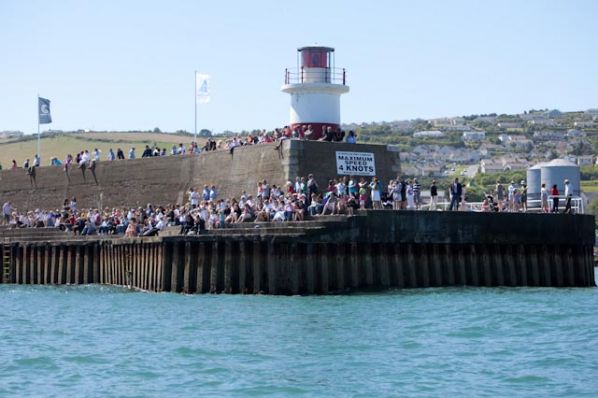
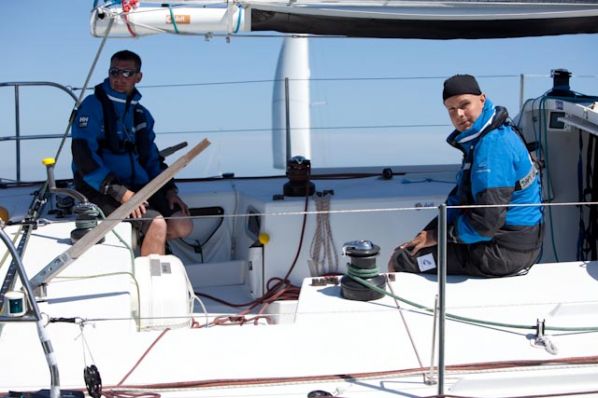

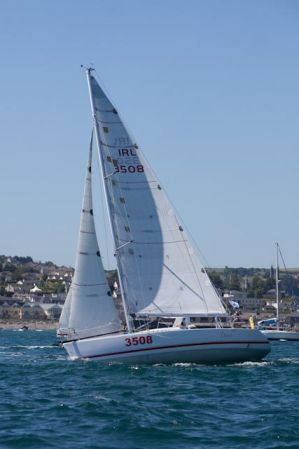
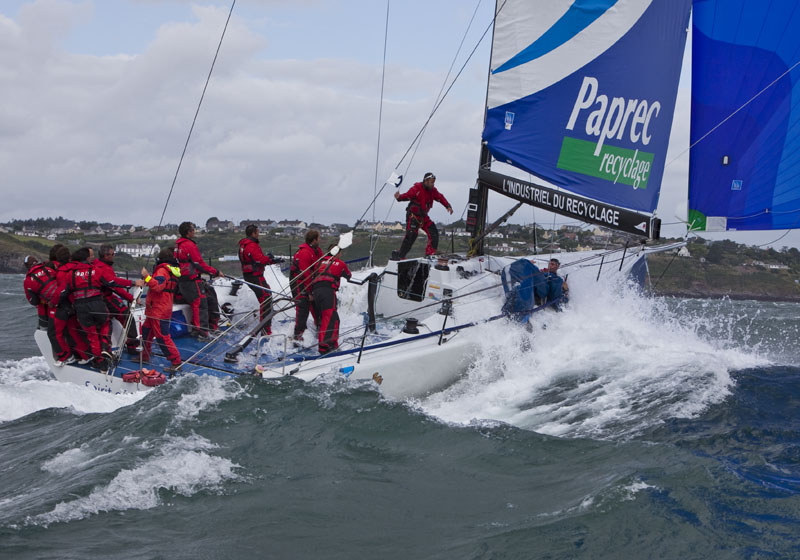
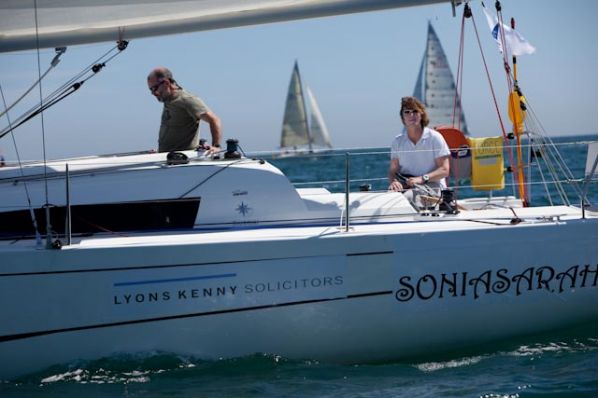

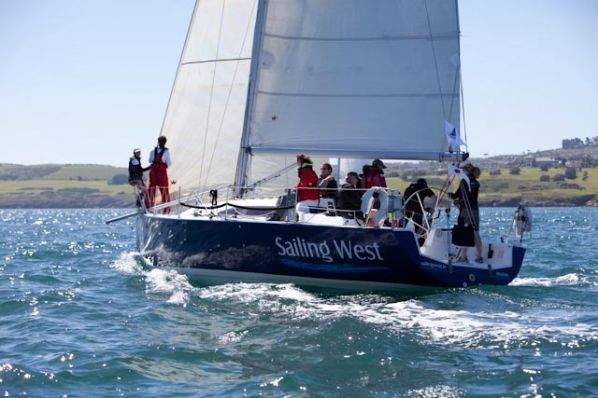

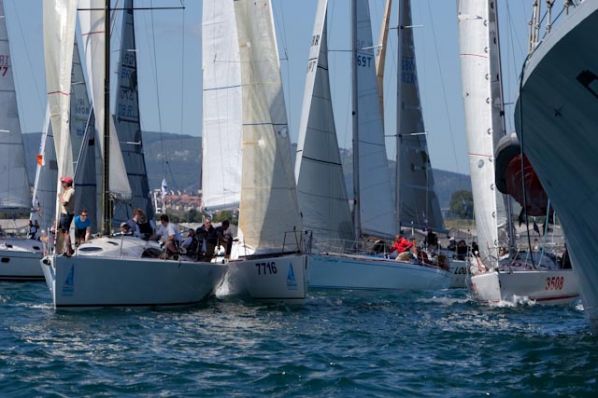
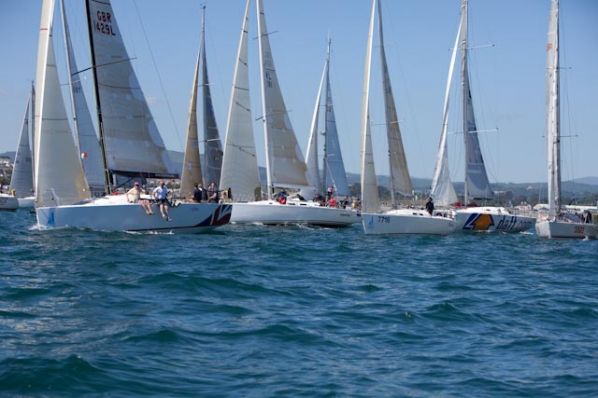
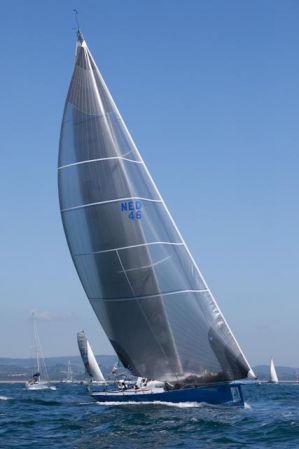
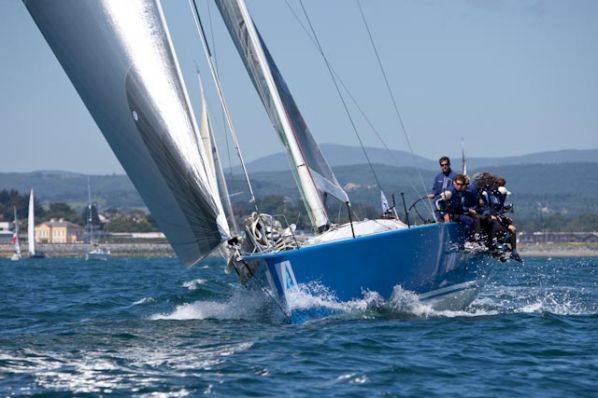
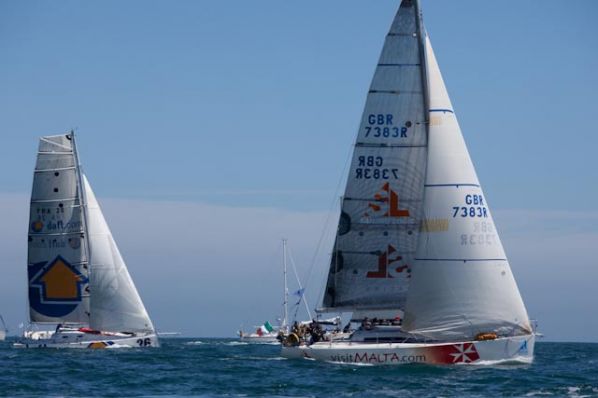
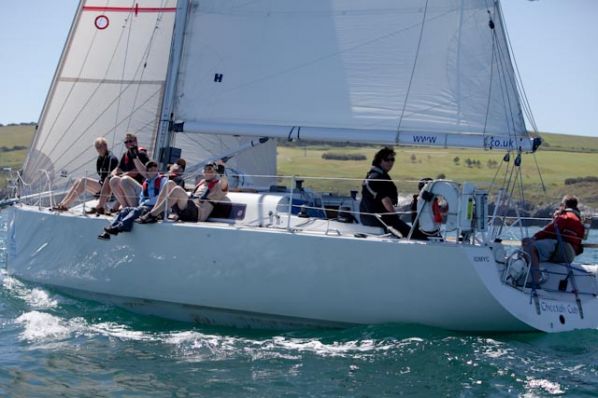
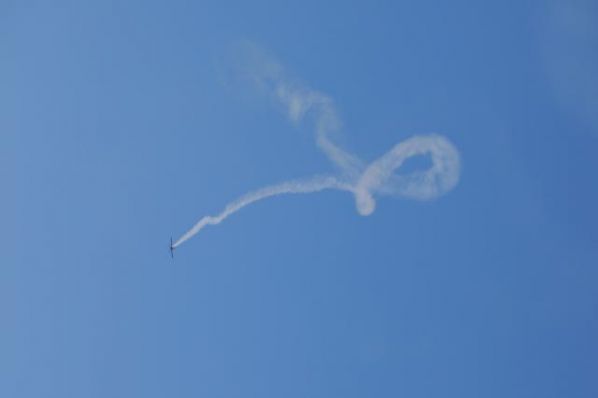
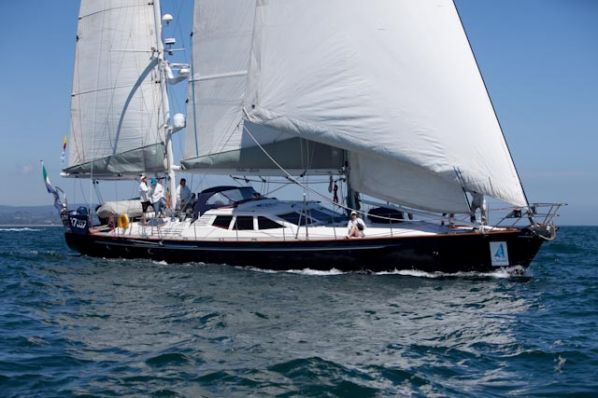
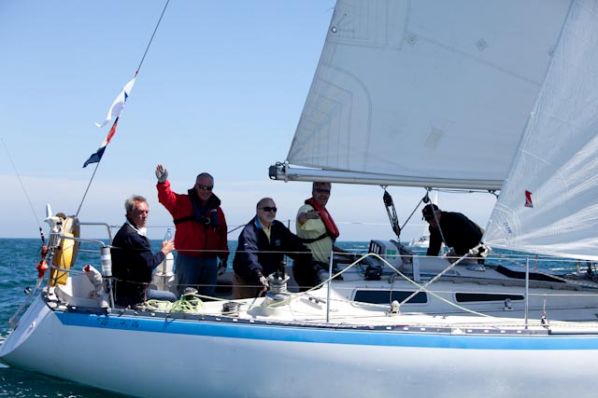
More on the Round Ireland Yacht Race:
Round Ireland Yacht Race 2010 Review
Round Ireland Yacht Race, Ireland's top offshore fixture
A Round up of 80 stories on the 2010 Round Ireland Yacht RaceRound Ireland Race 2010 - They're Off!
Dutch race veteran Piet Vroon's Tonerre de Breskens III made the most of the light northerlies at start time to take the advantage in the opening minutes of this year's Round Ireland race at Wicklow today. The fleet are sailing south now to the Tuskar rock and only one of the 37 boats has gone offshore, presumably in search of stronger wind. The bulk are tightly bunched along the Wicklow shoreline to escape the worse of an adverse tide with an expectation that winds are to turn southerly this evening. Start photos on afloat.ie gallery shortly. Tracker here (and screen grab below taken three hours after the start). Mike Broughton's race forecast here.
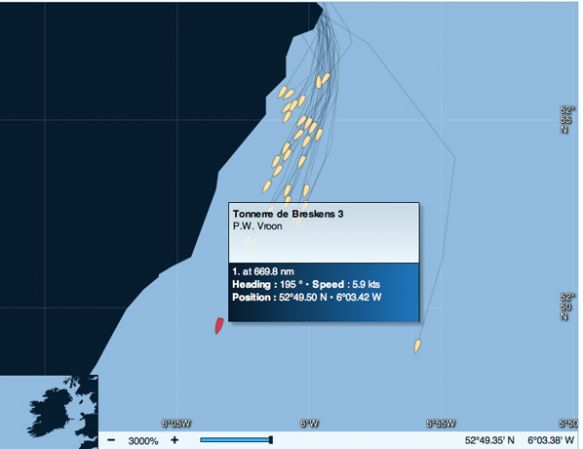
More on the Round Ireland Yacht Race:
Round Ireland Yacht Race 2010 Review
Round Ireland Yacht Race, Ireland's top offshore fixture
A Round up of 80 stories on the 2010 Round Ireland Yacht RaceStronger winds will bring the Round Ireland 2010 fleet home earlier than expected and it will be a fascinating, tactical race, says Wind guru Mike Broughton. The Irish Commodore's Cup team weather specialist says the 37 competitors in today's Round Ireland race will get a close hauled course along the south coast to the Fastnet tomorrow. After light northerly winds for the start at 12 noon today the fleet can expect winds to go southwest by 8pm. Mike's podcast prediction is below. Listen in!
More on the Round Ireland Yacht Race:
Round Ireland Yacht Race 2010 Review
Round Ireland Yacht Race, Ireland's top offshore fixture
A Round up of 80 stories on the 2010 Round Ireland Yacht RaceRound Ireland Race Fleet Ready in Wicklow Harbour
More on the Round Ireland Yacht Race:
Round Ireland Yacht Race 2010 Review
Round Ireland Yacht Race, Ireland's top offshore fixture
A Round up of 80 stories on the 2010 Round Ireland Yacht RaceSmall Boats Favoured for Sunday's Race Round Ireland
Twenty fours hours out from the start of the Round Ireland Yacht Race and the prediction that the 2010 fixture will be a small boat race is gaining ground as a high pressure settles over the Irish Sea today. In a fleet of 36 entries there are several small boats to choose a likely winner but in any line up it is hard to ignore the record of double race winner Eric Lisson's Cavatina, the veteran yacht from the Royal Cork Yacht Club with the lowest handicap of the entire fleet. The smallest boat is from the north, the First 31.7 Twister campaigned by Terry Fair and David Fletcher. The line up includes plenty of other choices but if it is small boat race it means any overall result many not be known for a week.
More on the Round Ireland Yacht Race:
Round Ireland Yacht Race 2010 Review
Round Ireland Yacht Race, Ireland's top offshore fixture
A Round up of 80 stories on the 2010 Round Ireland Yacht Race


























